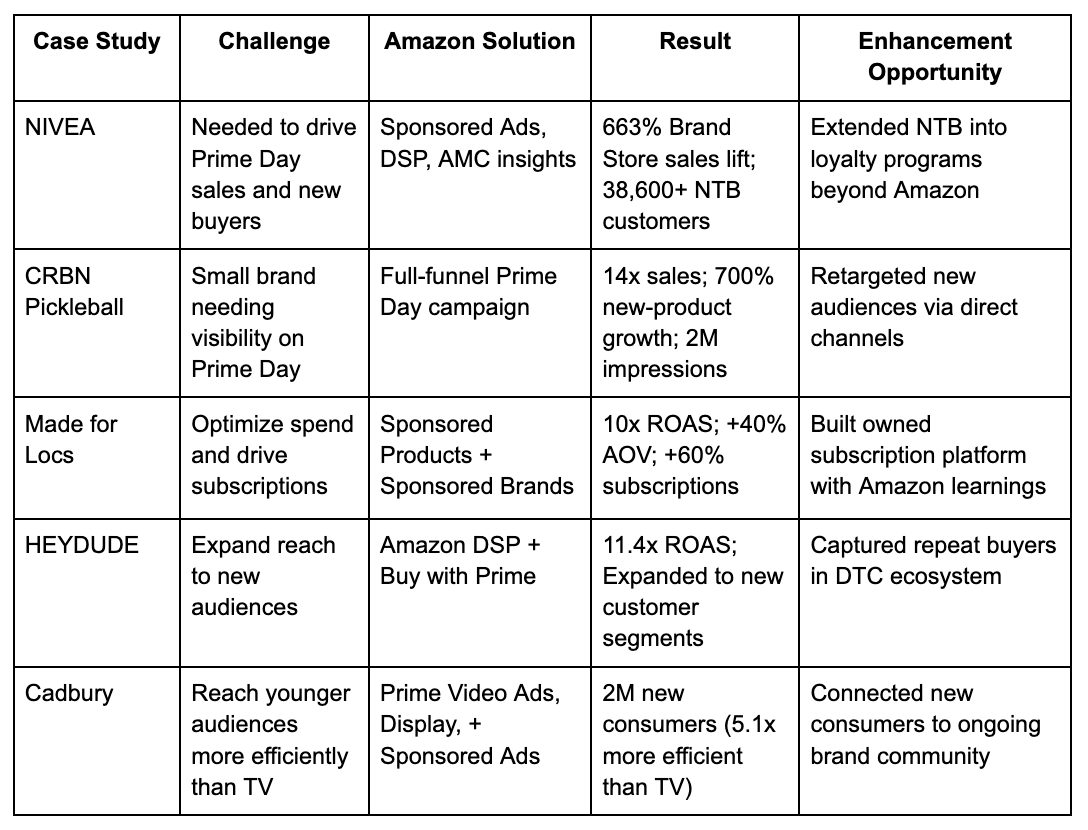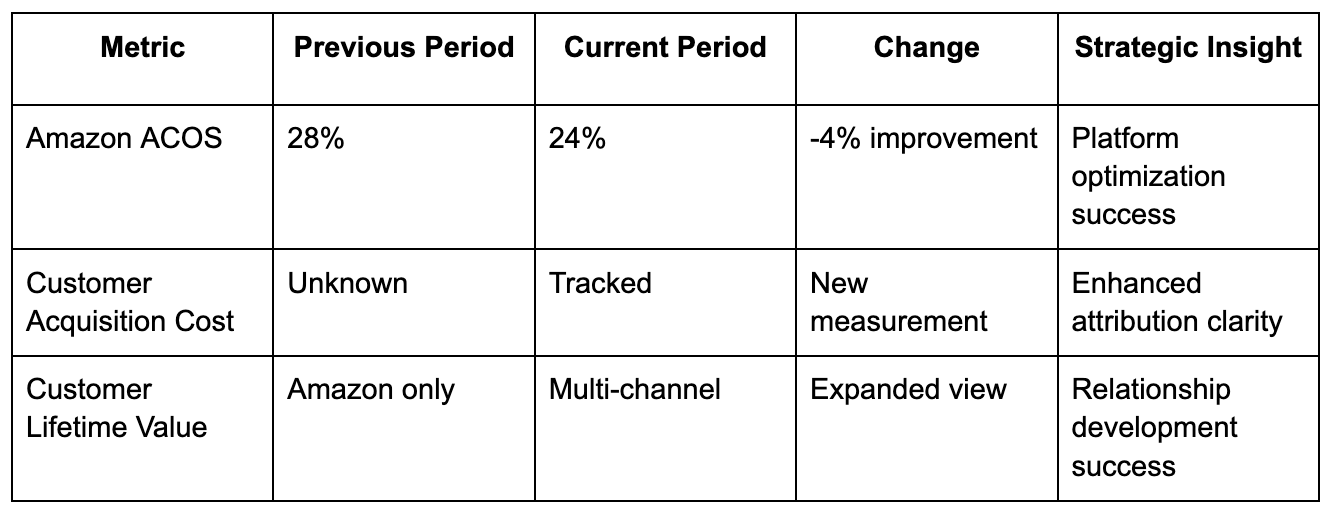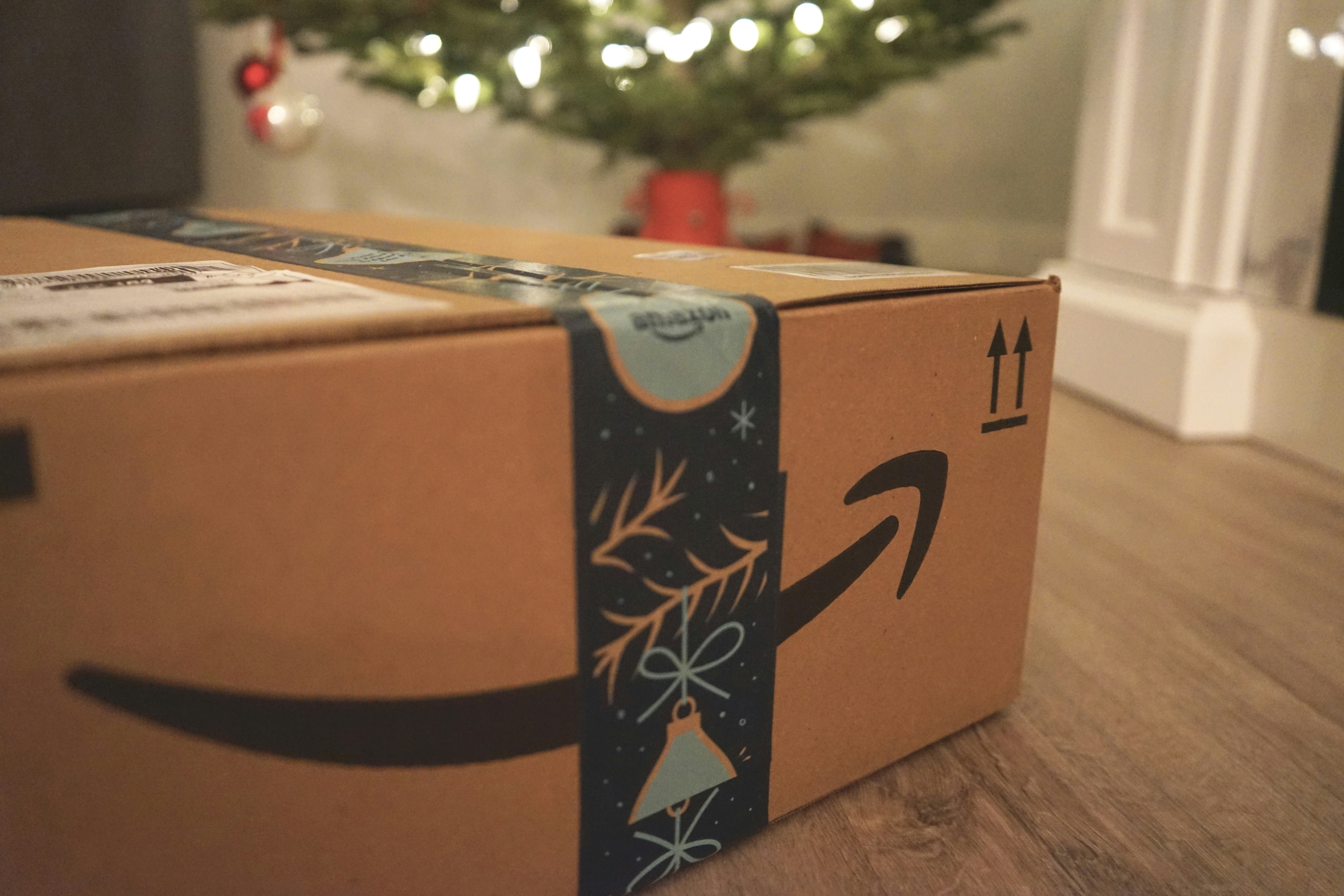By the end of Q2, Amazon’s ad business hit $15.7 billion, a 22% jump from 2024. For sellers, that explosive growth signals two things:
- You can’t ignore Amazon Ads.
- You’re competing in a more crowded auction every day.
This guide breaks down how to get the most out of Amazon’s ad formats, how to set up your campaigns for maximum ROI, and where to expand your marketing strategy beyond Amazon so you’re not fully dependent on a single platform.
Amazon Advertising Arsenal: Campaign Types, Features, and Strategic Implementation
Amazon offers several types of ad formats — each with itsown unique display and goals.
- Sponsored Products are cost-per-click (CPC) ads that promote your product on Amazon and other select apps and websites. When users click on the ad, they go straight to your product page. These ads show up based on keywords, which you can choose yourself or leave to Amazon’s algorithm.
- Sponsored Brands are video and rich display ads that promote your brand in Amazon’s store with video and rich display ads that display above, next to, or in shopping results. This format is also powered by keyword and product targeting.
- Sponsored Display Ads are ads that promote your brand on and off of Amazon and allow for retargeting.
Amazon Ad Formats

Most brands get the best results from mixing and matching Amazon’s various ad formats. But running different campaigns has downstream impacts on your strategy.
Producing new creative, changing your bidding strategy, constantly keyword pruning — all of these activities take time and money that resource and budget-constrained brands may not have. Plus, Amazon ads keep you inside of Amazon’s walls: you’re limited to their audience, their attribution, and their customer data. And ads get more expensive with every new seller that joins the auction.
So, while Amazon Ads are valuable, they can’t be your only marketing tool. You also need customer acquisition channels where you have full ownership of data and measurement.
Campaign Planning and Setup: ROI-Focused Strategy Development for Maximum Performance
The success of your campaigns depends on thoughtful structure. Here’s what to keep in mind when you’re building out your Amazon Ads:
Choose a Variety of High-Intent Keywords
Your brand or even your product names are a good start, but they can’t carry every campaign. To avoid budget cannibalization — where multiple ads fight for the same clicks — you need a broader set of high-intent terms.
Look first for low-competition keywords. Analyze search term reports and competitor listings. Over time, build a list that mixes exact match, phrase match, broad match, and auto campaigns (Amazon’s algorithm).
Keep Your Campaigns Simple
This will give you more granular control over your budget. Best practice is to stick with one ad group structure per campaign and five keywords max. This structure prevents overlap and makes budget adjustments precise.
Monitor Your Spend
Set a conversion goal before you launch your campaigns so you make sure your campaigns are paying off. Use Amazon’s native portfolio grouping to monitor budget by product or category, then reallocate to where performance is strongest.
Then, balance Amazon spend with other acquisition channels, like card-linked offers or other financial app ads to diversify your growth.
Track Core Metrics
You should be looking at performance as soon as your campaigns launch. On the backend of Amazon Ads, you’ll find KPIs like ACOS (advertising cost of sales), CTR (click through rate), conversion rate, and ROAS (return on ad spend). These KPIs set your performance baseline and highlight which creative works in which format.
Amazon also has tools that let you act on what you see. Use dynamic bidding to optimize your budget, and placement multipliers to push ads into premium spots. But be cautious — even small tweaks can eat your budget fast.
Don’t Solely Focus on Amazon
Sellers that scale well on Amazon Ads treat measurement tools with discipline. But they also supplement platform presence with:
- Direct customer engagement, reaching customers during purchase planning and budgeting decisions outside of the Amazon environment.
- Transaction-based attribution, giving them a clear view into customer lifetime value and acquisition cost.
- Organic customer relationships, through owned channels like email and loyalty rewards, reducing exposure to Amazon algorithm shifts and auction pressures.
Data-Driven Optimization: Performance Enhancement and Strategic Campaign Refinement
With an algorithm that changes as frequently as Amazon’s, Amazon Ads are far from set and forget. To get the best results, marketers must have an ongoing refinement strategy that includes:
- Continuous testing. This might include anything from adding or removing keywords to blocking irrelevant traffic with negative keywords to running A/B tests on ad copy to making small adjustments to bids.
- KPI-driven decision making. You should be paying close attention to the numbers in the Amazon console. Shifts in ACOS, CTR, and conversion metrics should inform where you raise bids, pause terms, or shift budget.
- Automation. Amazon supports bulk sheets, dynamic bidding, and automated bid rules out of the box, but you could also look into third-party tools that use more sophisticated machine learning to optimize your ads.
- Placement strategy. Amazon shows how campaigns perform across top of search, rest of search, and product pages. Most sellers lean on top of search to get higher conversion rates. But, depending on your budget, you might be better off going for cheaper clicks in rest of search.
Even if you take all of these steps consistently, it’s critical to remember that Amazon optimization ends at the Amazon transaction. You don’t see where the buyer came from, and you have no way of knowing if they’ll come back.
To build long-term growth, you’ll need a broader view. Aim to create:
- An end-to-end customer journey. Track how customers discover products before Amazon and how they behave after purchase. Can you find new channels to attract customers? What about to upsell or cross-sell?
- Lifetime value focus. Look past single transactions and build programs that keep customers buying again and again. A good example could be a diminishing discount structure — get 15% cash back on your first purchase, get 10% cash back on your first purchase, and get 5% cash back on your first purchase.
- Attribution clarity. Add transaction-based measurement beyond Amazon to see true acquisition cost and ROI across all channels.
Before and After Optimization Metrics

Success Stories: Real-World Amazon Campaign Performance and Strategic Lessons
If you’re not so sure about adding Amazon to your growth plans, here are some real campaigns that may make you want to reconsider:.
- For Prime Day 2024, NIVEA executed a full-funnel campaign using Sponsored Ads, Amazon DSP, and AMC insights. They saw a whopping 663% lift in Brand Store sales and 38,600+ new-to-brand customers, proving how coordinated strategies can both scale and acquire at the same time.
- Even small brands can punch above their weight. With a full-funnel Prime Day plan, CRBN Pickleball achieved 14x Prime Day sales, 700% new-product sales growth, 2M impressions, and 39K branded searches in just two days.
- By leaning into Sponsored Products and Sponsored Brands, Made for Locs adopted a test-and-learn approach that delivered a 40% increase in average order value and a 60% boost in subscriptions — a 10x return on ad spend.
- HEYDUDE combined Amazon DSP with Buy with Prime to expand reach. Their efforts generated an 11.4x ROAS while tapping into entirely new customer segments.
- Cadbury. Cadbury found that Prime Video ads were 5.1x more efficient than linear TV for reaching 18 to 34-year-olds. So they decided to run a cross-channel push using Prime Video ads, Display, and Sponsored Products. By combining formats, they reached 2M new consumers and had the highest conversion rate (3.84%).
These success stories highlight the underlying strategies that separate brands who simply advertise on Amazon from those who turn the platform into a true growth engine. Looking a little deeper at these case studies, a few themes stand out:
- Platform Optimization Excellence: Winning on Amazon requires ongoing optimization and full-funnel orchestration. Each brand did ample testing to get their great results.
- Automation Importance: The best results come from leveraging tools for efficiency and scale. They used platforms outside of just Amazon to continuously refine their campaigns.
Measurement Sophistication: Top performers push Amazon’s analytics to the limit but recognize its attribution blind spots. They run other kinds of performance marketing campaigns to round out their marketing strategy.

ROI Measurement and Reporting: Performance Analytics and Strategic Decision Making
As we mentioned above, Seller Central — Amazon’s reporting portal — shows you ACOS, CTR, and ROAS. Together, these KPIs show whether your ads are moving product and at what cost.
Beyond those core KPIs, you’re going to want to use Amazon’s other built-in reporting to see performance by placement type (top of search, rest of search, product pages) and keyword. That way, you can:
- Expand budgets when ACOS trends down
- Double down on keywords with high CTR and conversion
- Refine placements where ROAS is strongest
But remember: Amazon reporting stops at the transaction. You won’t see customer lifetime value, off-platform touchpoints, or the real cost of acquisition across channels.
Sellers who want the full picture need to connect marketing spend to verified customer revenue across all channels. That includes tracking:
- Overall customer acquisition cost: True CAC calculation including customer relationship development investment
- Customer lifetime value: Long-term value measurement beyond single Amazon transactions
- Attribution across platforms: Measurement systems connecting Amazon success with broader customer acquisition performance
Period-Over-Period Performance Template

Advanced Automation and AI: Technology-Driven Campaign Excellence and Strategic Scaling
Once campaigns span hundreds of keywords or dozens of products, automation is the only way to keep up. A few ways to streamline your ad management include:
- Bid management automation can save weeks of manual work.
- Machine learning systems can run millions of adjustments across bids and placements.
- AI-driven keyword targeting, automated reporting, and cross-account scaling. Other third-party tools can help you free up more time to focus on strategy, creative, and customer relationships — while increasing your ROAS.
Sellers who think bigger apply automation outside Amazon too, with:
- Customer acquisition automation, to manage customer relationships and engagement beyond Amazon platform limitations.
- Cross-platform optimization, to optimize customer acquisition across multiple channels with unified measurement.
- Relationship development automation, to support customer lifetime value enhancement through direct engagement channels.
All of these methods save you time, meaning you and your team members have more time to spend on other strategic projects. They also help you scale faster — without sacrificing results.
Time and Cost Savings from Enhanced Automation

Cross-Platform Integration: Amazon Success Within Broader Customer Acquisition Ecosystems
We’ve already said this, but it bears repeating: to build durable growth, sellers need to connect Amazon performance with broader acquisition strategies.
Start by integrating Amazon learnings with your wider retail and ecommerce plans. Use the keywords and creative that work on Amazon to inform other search, social, and retail media campaigns to keep your messaging consistent and scale what already converts.
Next, expand your retargeting beyond Amazon’s ecosystem — after all, shoppers don’t just browse inside the Amazon marketplace. Reengaging them on other platforms builds brand recognition and nudges them closer to conversion.
Finally, take advantage of other growth strategies, like cash back offers. Reaching consumers when they’re already in a spending mindset (using their banking app) increases the chances they’ll make a purchase. Unlike interruptive ads, these offers feel relevant and provide first-party transaction data you can use to inform and refine other campaigns.
The integration playbook looks like this:
- Use Amazon campaigns to capture demand.
- Feed performance data into direct channels.
- Run cash back offers through a platform like Kard.
- Measure results across all touchpoints to understand real CAC and LTV.
When marketplace performance and direct channels reinforce each other, sellers gain reach and build a customer acquisition engine that lasts.
Cross-Channel Campaign Benefits

Strategic Insights: Amazon Advertising Excellence and Enhanced Customer Acquisition Opportunities
Amazon sellers who build clean campaign structures, test weekly, and invest in automation see real returns. But the reality is that Amazon is still Amazon. The platform controls the data, the attribution, and the auction — which means you can’t rely on it alone.
Instead, treat Amazon as a foundation and layer in acquisition they own. That means:
- Keeping Amazon campaigns efficient with structured bidding, automation, and testing.
- Layering in automation and AI to free up time to invest in other direct acquisition channels.
- Adding transaction-based attribution outside Amazon to see the true cost and value of each customer.
- Building direct relationships through rewards, loyalty, and in-app placements where they control the data.
This two-track approach (Amazon performance plus owned acquisition channels) sets sellers up to grow without being boxed in by a single marketplace.
Frequently Asked Questions About Amazon Ad Campaigns
Q: What is an Amazon ads campaign?
A: An Amazon ads campaign is a paid advertising program enabling sellers to promote products through Sponsored Products, Sponsored Brands, and Sponsored Display formats to reach targeted shoppers within Amazon's ecosystem. While these campaigns provide essential platform visibility, successful sellers recognize the value of complementary customer acquisition channels that offer direct customer relationships and enhanced attribution beyond Amazon's controlled environment.
Q: What are the three types of Amazon advertising?
A: Amazon's three main ad types include Sponsored Products for individual item promotion, Sponsored Brands for brand visibility with custom creatives, and Sponsored Display for retargeting both on and off Amazon's platform. Each type serves specific platform objectives, though sellers increasingly supplement Amazon advertising with direct customer acquisition channels like financial app advertising to build relationships beyond platform transactions.
Q: What is the lawsuit against Amazon Prime ads?
A: The lawsuit against Amazon Prime ads involves legal challenges regarding Amazon's advertising practices, consumer disclosures, or regulatory compliance within Prime video or retail platforms. These legal considerations highlight the importance for sellers to diversify customer acquisition beyond single platform dependence, building direct relationships that provide greater control and reduced regulatory exposure.
Q: How to find Amazon campaigns?
A: Sellers access Amazon campaigns through Seller Central or Advertising Console, navigating to Campaign Manager dashboard for viewing, creating, and managing all active and historical ad campaigns. While platform tools provide comprehensive campaign management, successful sellers also implement customer acquisition measurement systems that track performance beyond Amazon's analytics limitations.
Q: What is the cost structure of Amazon ads?
A: Amazon ads operate on cost-per-click (CPC) models where advertisers pay for user clicks, with costs varying based on competition, targeting, and daily budgets. Rising competition increases Amazon advertising costs, making complementary customer acquisition channels increasingly valuable for sellers seeking cost-efficient growth and direct customer relationship development.
Q: What are leading strategies for effective Amazon ad campaigns?
A: Leading strategies include selecting appropriate ad formats, targeting high-intent keywords, structuring campaigns for budget control, continuous A/B testing optimization, and integrating automation for scalable management. Advanced sellers supplement Amazon optimization with customer acquisition channels that provide transaction-based attribution and direct customer relationships beyond platform limitations.
Q: How do brands measure ROI on Amazon ad campaigns?
A: Brands measure ROI through Return on Ad Spend (ROAS), Advertising Cost of Sales (ACOS), Click-Through Rate (CTR), and conversion rates using Amazon's analytics tools and custom dashboards. However, Amazon measurement focuses on platform performance rather than complete customer lifetime value, creating opportunities for enhanced attribution through direct customer acquisition channels.
Q: What are examples of successful Amazon advertising campaigns?
A: Notable successes include Roomify's 273% revenue growth with Sponsored Products and Fliegende-Pillen.de's automated bid management reducing ACOS by 33% while saving significant time. These successes demonstrate platform value while highlighting opportunities for sellers to leverage Amazon success for enhanced customer acquisition through direct relationship development channels.
Q: How does automation improve Amazon ad campaign performance?
A: Automation manages high-volume bids, saves time, applies machine learning for dynamic optimizations, and improves efficiency with bulk updates, helping campaigns scale while maintaining cost control. Automation success on Amazon creates resource availability for developing customer acquisition channels that provide direct relationships and enhanced attribution beyond platform analytics.
Q: How can Amazon ad campaigns be integrated with other retail and app marketing efforts?
A: Amazon campaigns integrate with broader strategies through cross-platform retargeting, brand consistency, and native in-app promotions leveraging first-party data for unified performance. Enhanced integration includes financial app advertising where customers make purchase decisions, providing transaction-based attribution and direct customer relationships that complement Amazon platform success.


